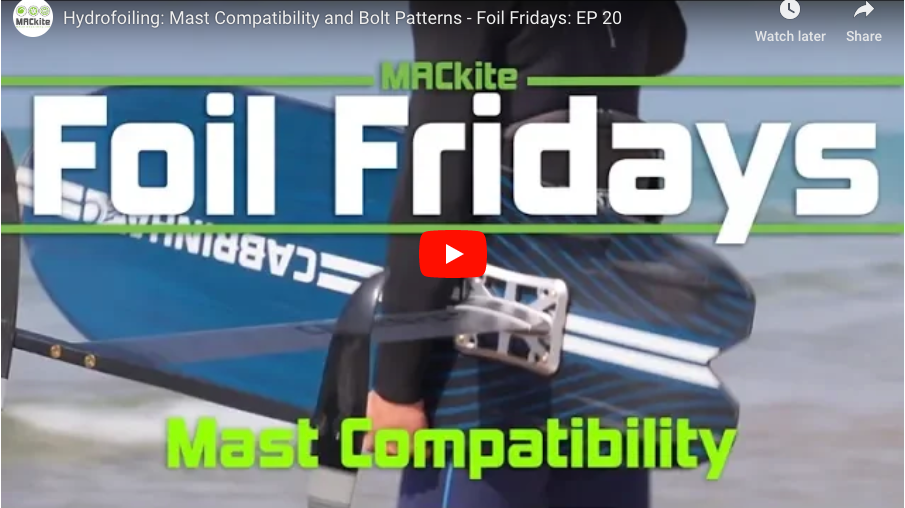Hydrofoil boards, bolt patterns, and compatibility
There are various ways to connect a hydrofoil to a foil board.
The Plate System
Alloy Standard (90 x 140mm)
The most common today is the plate system. Connecting a hydrofoil to your board is simple using a plate mount. However, you need to make sure they are compatible with regard to their bolt pattern, or spacing between the screws and nuts. There are two primary bolt patterns that have emerged as the standards. We will call them the "Alloy Standard" and "Carbon Standard".
Alloy Foils
Figure 1: Hydrofoil Bolt pattern chart
Plate System Exceptions
The "Alloy Standard" has a bolt pattern 90mm wide and 140mm long. We call it the alloy standard because the majority of alloy foils in the market today use this pattern. There are two exceptions to this rule. The North Speedster foil is alloy but uses the "Carbon Standard," which is 25mm longer.
Figure 2: Cabrinha Foil Mast Plate
The second exception is Cabrinha foils, as you can see in Figure 2. While they do have a 90x140mm (alloy) bolt pattern, it is threaded for use with their Double Agent board which uses a "bolt through deck" type of attachment. The Cabrinha foils also have a second set of holes with spacing at 90x110mm that employ the countersunk style hole common for other foils. This allows them to be connected to boards using track mount boxes.
Carbon Plate Standard
(90 x 165mm)
Figure 3: MHL Lift carbon mast
All notable carbon mast foils with a plate/ track system use the 90x165mm bolt pattern. In addition to those carbon mast'd foils, Duotone also uses the 90x165mm bolt pattern for their alloy foils and fixed pattern boards. The larger bolt pattern is to help support the carbon construction, but also helps to spread the load to the board during high-stress situations that carbon foils are typically used in, such as jumping and racing.
Boards
Figure 4: Hydrofoil Board Inserts- Track vs. Bolt through vs. Fixed pattern
Standard Hydrofoil Board Mounting
A plate foil uses one of three methods:
- Track
- Bolt through
- Fixed pattern
Track Mount
By far the most popular is the "track mount". This consists of two polymer channels set 90mm apart. This allows for the foil to be mounted to the board regardless of the length dimension and provides fore/aft adjustment to fine tune your ride. Depending on your gear choice and riding style, this could be either a minor or major benefit. In addition to being versatile and adjustable, this system is also known to be the most durable.
Bolt Through
The next most popular would be the "bolt through method". This method uses a set of holes in the board that are not threaded and pierce the board from base to deck. Some boards offer multiple mounting positions that allow for some stepped adjustments. This system uses a longer bolt and either a T-nut or threaded mast collar to secure it. Bolt through systems are known to be the second most durable as they do not require a strong hold on the core, and the threads can be replaced in most circumstances. Some brands using this style are Moses and Cabrinha (Double Agent board).
Fixed Pattern
The most rarely seen is the "fixed pattern with threaded inserts". This is a fixed bolt pattern with threaded inserts similar to your twin-tip strap mounting points. This is a very clean connection but lacks adjustment and can be prone to damage if ridden in extreme conditions since it relies on smaller connections to the core and glass of the board.
Location and Stance
One popular consideration when pairing any foil with a board, outside of their bolt pattern compatibility, is the location of the foil in relation to your stance. Bolt through, fixed patterns, and even some track boxes can leave you with an awkward stance when paired with certain foils. Any larger wing will push your ideal stance forward on the board. Failure to push your stance forward will leave you balancing all your weight on your front foot.
Because of this, riding straps or a small board with a large wing may require your foil to be mounted further tail-ward for a proper stance. Sadly, not all boards allow for this, so keep your eye on where your stance might be in relation to your available foil mounting options.
Have more questions? As always, feel free to reach out to us for advice via 800.622.4655, live chat, or email kiteboarder@mackite.com
Written and produced by Tucker Vantol, Ryan (Rygo) Goloversic
Tucker Vantol
Mackite's resident surf and "Hydrofoil junkie." You can either catch him on the phones or on the water at dawn testing new gear. He is proficient at myriad sports, a shaper, and passionate about getting his water time. When he discovered kiteboarding it took over as his predominate sport. The same could be said about hydrofoiling.
Recent Posts
-
Kiteboarding Tricks | How To Do A Backroll Hat Drag
You can use a little creativity to switch up even the more basic tricks and add a little f …26th Jul 2024 -
KT Ginxu Step-Bottom and Foil Drive Systems | A Perfect Match?
The step-bottom feature of the KT Ginxu foilboards is a big help in releasing the surface te …24th Jul 2024 -
Starboard Ace Air Inflatable Wing Foilboard Review
It's Wing Wednesday, and today Tucker's got an inflatable foilboard, the 2024 Starboard Ace …23rd Jul 2024




